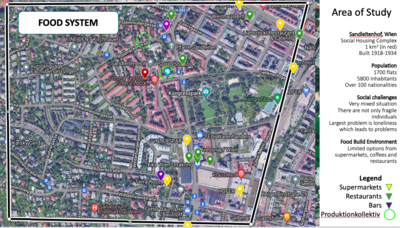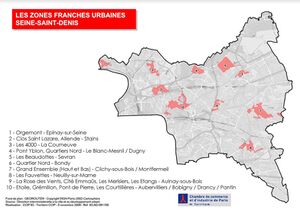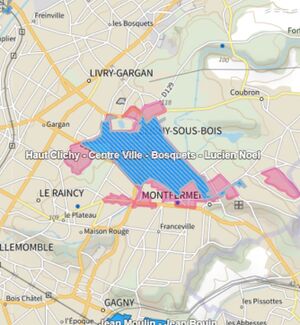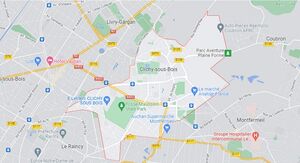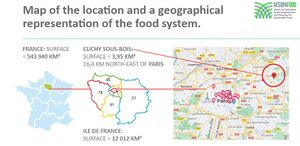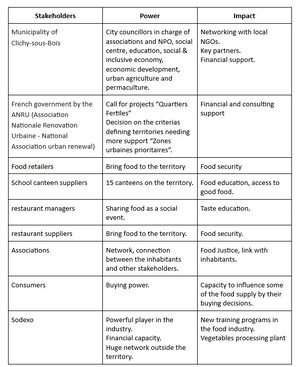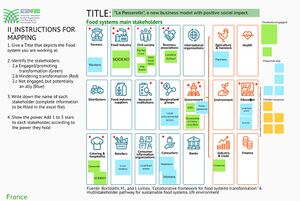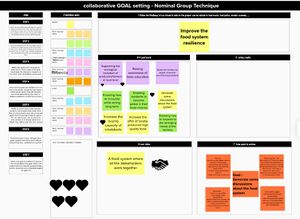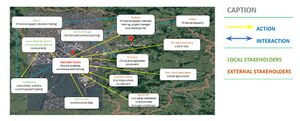Student teams / working groups
Here the work and the activities of the student teams are presented.
Warsaw
Exploring the field of play
Our task (a local case study or living lab relating to a community)
Increasing the circularity of the Hoe&Sun community garden
The main theme we address for this task: food security, metabolism/circular economy, access to land, food justice, ....
Circular economy - organic waste management
Our skills and methods to address the assignment (methods of your discipline, personal skills)
- monitoring the quality of compost produced from automatic composters on the basis of biomonitoring using phytotoxicity tests
- urban analysis (accessibility, functional mix)
- composting of green and food waste as a form of sustainable development
Mapping the foodscape, analysis and challenges
The part of the food system we study and why we selected this
composting in a community garden - local organic waste management
The system with its elements, relations and stakeholders
- Community garden incubated by an NGO (Lab of the Commons) - Surrounding NGO's in an self-managing NGO cluster in a former residential cluster of houses - Gardeners for leisure - Visitors to the NGO cluster (cultural and educational services) - Patients of the nearby daily hospital for mental illnesses - Municipality - land owner, managing of the surrounding public green areas.
The role and position of the stakeholders in terms of power and impact
- NGO - the Commons Lab (Pracownia Dóbr Wspólnych) - organizer, land renter (*** power)
- Gardeners - providers of some organic waste (** power)
- Municipality - land owner, short term lease, management of surrounding green areas (***** power)
- Disadvantaged groups – homeless, single parents, refugees (* power)
- Lab of the Commons represent the garden in contact with external partners, institutions, city hall etc.)
- The Municipality is an owner of the land, which is leased for a medium term (a few years) on special terms by an NGO (Lab of the Commons/Pracownia Dóbr Wspólnych)
- Gardeners are here in free time, paying small fee, they are responsible for their plants
- Disadvantaged groups are encouraged to use the garden and multifunctional hall
The main challenges in the food system to contribute to the common good
- Legal issues - sanitary restrictions for institutions
- Sanitary issues: rats emerged (solved technically)
- Food waste has to be selectively collected (we cannot insert each type of Food Waste), it is important to keep N:P:K (natrium, phosphorus, potassium) in good proportion
- Compost which is produced is not checked by its chemical properties (pH, EC - electroconductivity) so it can be the reason that product cannot be stable
- Trouble keeping constant compost material proportion (green waste:food waste ratio)
- More info
Assignment 3 Collaborative goals and visions
Describe your sustainable food planning challenge you want to tackle / Make a problem-statement based on the food systems evaluation and assessment.
Introduce the main stakeholders who contribute to the goal-setting. Let us know who is involved in the visioning process and why ?
Let us know how the visioning process took or is taking place?
How has this vision been translated (will translate) into an implementation strategy?
Madrid
Exploring the field of play
Our task:
- Developing a plot proposed by the project ‘Barrios Productores’ of Ayuntamiento de Madrid (Municipality of Madrid), addressing underused spaces within Madrid, helping climate mitigation and regeneration of vulnerable neighbourhoods.
The main themes we address for this task:
- Access to land / agro ecological land use development → land incubator for farmers to access land, skills, infrastructure and markets at the same time. Reuse abandoned lands to make them productive and meeting places in the neighborhood.
- Circular metabolism
- Short chains and food networks
- Food justice → link with solidarity food pantries
- Community agriculture → project of community kitchen, collective investment and labour; social links and pedagogical values
Our skills and methods to address the assignment:
- Mixed-method and interdisciplinary research, including field data collection, statistical and probabilistic analysis and related quantitative as well as qualitative methods
- Multi-criteria analysis and coordinating different specialities
- Architectural design; urban, spatial and territorial planning
- Governance, citizenship participatory process management, team working, community mediation & engagement in co-design approaches and solutions
- Risk management
- Sustainable project and process management
- Ecosystem services, green infrastructure, nature based solutions, hydrological modelling and biodiversity management and promotion
Additional methods and concepts that were presented in the first three sessions that are suitable for addressing our task:
- Agroecology, food democracy, food justice (session 1)
- Spatial planning and agroecological urbanism (session 2): participation for a new paradigm: solidarity, mutual learning, interspecies exchanges, environmental stewardship, food sovereignty
- Food networks and multi-actors coordination (session 3): municipality, farmers, food pantries, inhabitants…
Mapping the foodscape, analysis and challenges
The part of the food system we study and why we selected this
- Production → plots of production
- Consumption → solidarity pantries + local commercialization
- Waste → composting in situ, recycling water
+ Very multidimensional: social gathering, educational purposes, participating to the enhancement of environmental conditions and biodiversity, efficient water use, reduction of the so-called “heat island” effect, the use and production of renewable energy etc., without missing its landscape component, helping the social validation of the inhabited surroundings and actually producing new ecosystems, half-way between nature and culture, …
The system with its elements, relations and stakeholders
Why this plot? Hesitations with Vallecas, closer to the solidarity pantry
- 11125 m2 > economical viability of production
- Potential access to permanent marketplaces (potentially with a lower cost item reserved for agroecological products)
- Proximity to a plot of the 'RED de huertos comunitarios' (Community garden network) which allows an exchange of knowledge, without there being many projects in the close surroundings (unlike in Vallecas where there are already many shared gardens)
- Important number of open spaces (more than in Vallecas)
- Most part of the perimeter is already closed, so the investment to close it for avoid product thefts would be lower
- Manzanares River and the fact that it is a passageway to the highway, it is a perfect space for botanical education of school children as well as a simple meeting point, with activities and occasional festivals
- The role and position of the stakeholders in terms of power and impact
..
The main challenges in the food system to contribute to the common good
- Plot cultivable? (access to water and electricity, problem of proximity of the highway, soil fertility, soil pollution)
- Collaboration with community garden possible?
- Collaboration with schools and institutes present?
- Connection with local actors, community kitchen and solidarity pantries?
- Thieves and vandals?
- Enough biodiversity in the environment to fight against pests and get pollination services?
..
Collaborative goals and vision
Problem statement
- To mitigate climate change, and urban food security challenges, through participatory and sustainable urban food planning coupled with an efficient land-use in marginalized and underprivileged communities of Madrid.
Challenges
- Design and establish a sustainable urban farming
- Participation related to: Farming, composting, awareness raising & advocacy
- Funding avenues
- Water availability
- Soil fertility
- Short food chain
- Waste treatment
Goals
- Provide adequate, nutritious, and sustainable food to the community
- Promote circular economy through local production, consumption, and waste treatment
- Increase employment and active citizen participation in urban sustainability practices
- Empowerment and inclusiveness
- Improve environmental conditions of the resource nexus
- Secure funding for the project
Strategy and interventions
What aspect of the food system is the action trying to address and transform?
- Food production relocation far away from Madrid
- Disconnection between citizens and food production
- Current dependency on food surplus for the solidarity pantry
- Farmers’ precarity and lack of generational relief
- Urban food security
- Damage to soil fertility and GHG emission
+ unemployment + heat waves, storms and droughts (and aggravation with climate change) + waste of energy in transport, soil pollution, air pollution
What is driving the change? How is it shaped?
- State-led: municipality (Ayuntamiento de Madrid)
- Citizen-led? > How to break up with the top-down approach and organize participation?
- neighbourhood table of discussion with the different stakeholders (neighborhood associations and entities, community pantry, NGOs, neighbourhood food related business etc.)
What is already in place? How are you building on this? What is missing? What is key (and cannot be left out)?
Already in place:
- A community productive garden with people who likes to produce food and experience
- A plot the city council wants to convert to an urban food production plot
- The reliance of an existing food poverty/food bank initiative on surplus food
Missing:
- Connection between the existing food pantry with urban production
- People producing food professionally inside the city
- Link between volunteering and professional work
> Food production // job development
> Volunteering // food and skills
Key:
- Self-sufficiency, economic autonomy
- Involvement of inhabitants
- Diminishing the reliance of an existing food poverty/food bank initiative on surplus food by connecting it with urban production.
What may follow? In 1 year, in 5, in 10? When will you consider this action to be successful? What should it yield? How may it affect the food system?
In 1 year:
- Involve local stakeholders
- Achieve sufficient soil fertility
- Access to irrigation water
- Implementation of our action plan
- Crop selection for seasonal cultivation
- Funding avenues
In 5 years:
- Maintain active participation of stakeholders
- Economically self-sufficient
- Strengthen the collaboration with the Solidarity Pantry
- Produce stable employment
- Soil quality and biodiversity improvement
In 10 years:
- Expand to other regions
- Collaborate with other initiatives, NGOs, …
- Expand services, e.g., Nature-Based solutions, training, seed bank…
- Extend outreach, e.g., Website, manuals, guides,...
Monitoring and evaluation
What did you like most about the AESOP4FOOD course?
- Knowledge about the topic from lectures, looking the food system in an holistic way
- Flexibility
- The interaction with people with similar views on sustainable development
- The case study in the framework of the Living Lab (gives a more concrete and practical approach)
- Cases from different countries gives a broader perspective
- Multiculturality
What did you like least about the AESOP4FOOD course?
- That it was fully online, you do not meet the people in real life
- Not very familiar with slack and wiki
What will you take home?
- International community with diverse points of view
- The importance of planning for the food system
- A broader perspective on the current issues and actions
- The spatial planning approach for the concepts around agroecology
- New knowledge and tools
How do you think this course could have been improved?
- To make a stronger combination with digital and analogue experience
- Maybe through more exchange between the Living Labs, for example by organizing breakout rooms in mixed groups (members of different cities together)
- Push us further in the reflection for the evaluations: reinforce business plan and spatial planning tools, and also how to build/strengthen a community (because I think strengthen a community is different from the tools on participation)
- More clarity and guidance on the purpose and expected results for the assignments
- Tutoring from the mentors to advance the assignments more efficiently. (E.g. weekly meetings)
Did the teaching and learning method work for you?
- Yes, it worked fine for me. What I learned in the digital platform I can apply in the real workshop / real world.
- In-person methods would have been more efficient to keep the group members active and engaged.
How did COVID-19 affect your team work?
- Indirectly: we were familiar with online working tools, it affected our socializing skills
- Our colleague got COVID-19 and it was hard for him to attend the presentation
Did the content/course phases come together coherently throughout the seminar?
- Yes, we were always aware of the larger framework of the classes, especially through the Living Lab as this exercise forced the group to think step by step, without losing sight of the main goal.
Did the assignments serve the Living Lab activities well?
- It gave an idea of what we had to do.
- Instructions were sometimes repetitive, and did not always help us move forward with the project
- Assignments required a tremendous amount of energy from team members that were present on-site. This situation made it difficult to arrange a fair distribution of tasks
What have you learned as a group in terms of addressing a sustainable food planning challenge?
- Engagement and maintaining it, on all levels is the key to success
- Presence of team members on-site is necessary
- Clear differentiation of roles and responsibilities
Mention one lesson learnt for each individual team member.
- Ana: To step back a bit from my way of thinking to give space for other opinions.
- Joana: The different background gives different visions that makes you to grow. The resolutiveness and team working tools of my colleagues. Their professional way of presenting our work to the audience.
- Lariza: The importance of a collaborative and multi-disciplinary approach to address food system challenges.
- Jose-Manuel: To have a larger vision of the actors involved in the food system and to discover new ways to deal with difficulties that appears when you want to boost a change in the food system trying not to leave anyone behind.
- Pim: Working in a different context than the one in my home country
- Ioana: The importance of involving stakeholders in such projects
- Taha: A self-reflection on how to properly transfer messages and connect. A better job in establishing a good
collaboration was possible.
What might be the most important next step or action for your Living Lab?
- To find ways to properly match and coordinate roles and responsibilities within our group.
- A planned participatory process.
- Design an action plan, as well as a business proposal that secures the projects’ long-term self-sufficiency.
- Collaboration with other NGOs, initiatives, and start-ups, e.g., the green toilet project for irrigation water and soil fertilizer; The GRINO start-up for supplying energy and irrigation water using solar panels.
- Monitoring and evaluating each phase accordingly and making adjustments taking into account all the actors.
Vienna team
The Produktionskollektiv Wien is an association for social and cultural urban development based in the 16th district of Vienna (Ottakring). The association was founded by Dipl. Ing. Karsten Michael Drohsel (Urban and Regional Planning TU Berlin). The local focus of the association's work is in the Sandleitenhof, the largest municipal building from the time of "Red Vienna". The focus is on neighborhood activation and networking projects as well as the development of playful teaching, learning and participation formats.
The team was form by: Daniel Lorenzo Torella, and Isaac Guzman Estrada. With the tutoring support of Arati Uttur and Karsten Michael Drohsel.
Exploring the field of play
- The main theme we address for this task: Food democratization and self-sufficiency are the main areas on the food system we focus.
- Our skills and methods to address the assignment: We conducted a desk research approach, and expert consultation. The use of online map and literature review helped to understand the context and background of the area.
- Exploring the field of play: Through conversation with our tutors, and in particular with Karsten, who is in the area, we came to have a better understanding of Prouktionskollectiv work, the built relations, and plans to move forth. In addition, to an explanation on the different ongoing and past projects in the area.
Mapping the foodscape, analysis and challenges
- The part of the food system we study: Food democratization and self-sufficiency.
..
- The system with its elements, relations and stakeholders
...
- The role and position of the stakeholders in terms of power and impact: By mapping the physical environment of the area, the system network mapping allowed us to identifying the interconnections between the actors, assets, the power dynamics and impacts. With this initial steps we could diagnose the current state of the food system in the area. As a main conclusion, there is a rich area of opportunity. Produktionkollektiv Wien has been an active actor and build a solid relation between key stakeholders. However, there is a strong lack of interest of the residents, thus participation and how to activate it is one of the main challenges
..
- The main challenges in the food system to contribute to the common good
- Add important graphics from your presentations to support the text above. (add/ subtract number of images. you can re-name this line to suit your graphics)
- Example.jpg
Caption1
- Example.jpg
Caption2
</gallery>
Add Map to Page
French hub
Assignment 1 Exploring the field of play
Our task (a local case study or living lab relating to a community)
We are working on the case study La Passerelle, in Clichy-sous-Bois. We aim to analyze how a niche innovative project can grow roots in a local food system, when implemented by an external stakeholder, in that case the private company SODEXO. La Passerelle, is a third-party facility created by SODEXO, a leading foodservice company, committed to social innovation and research with the objective to experiment with new business models that create social and environmental impact in local areas. They also meet the expectations of clients, consumers and their employees and the inhabitants.
La Passerelle is a pilot project part of a CSR approach aimed at creating third places in less privileged neighborhoods that enable action to be taken as close to the ground as possible in three areas:
- Health through food: to share their knowledge of nutrition and balanced diet, to enable everyone to have access to quality food on a limited budget.
- Employability: to create, in conjunction with local players (public, private, associations) in charge of training, employment and integration, training and employment paths for local residents, which are all responses to Sodexo's recruitment challenges.
- Social cohesion: develop local facilities to organize activities and workshops accessible to local residents in conjunction with local associations
The main themes we address for this task: food security, metabolism/circular economy, access to land, food justice, etc.
The main theme we address is food justice. A key point when it comes to the development of a food system is looking closer to more inclusive innovating examples, where innovators, users, volunteers, corporates, public institutions work together. We want to question their embedding in the local food system, with a case study based on "La Passerelle".
By embedding we mean : how can such a project grow roots into a local food system ?
Our skills and methods to address the assignment (methods of your discipline, personal skills)
- Gaelle: is both a sociologist and anthropologist. She has more than 10 years experience in advocating short supply chains, and is a specialist of community supported agriculture. She has participated and organized many university-level workshops.
- Eurielle: training on educating about food balance with a small budget. She can provide training on workshops on how people can improve their consumption.
- Luisa: with 20 years of international experience (in Germany, Italy & France) and a double expertise in communication and entrepreneurship, I privileged collaborative co-creation approaches for developing innovative solutions/projects. My favorite topics : sustainable food circular economy, green-deeptech and women’s rights.
- Rebecca: active listening, communication, leadership, management and problem-solving skills. Anthropologist field study methods, with an expertise in active participatory field study.
Additional methods and concepts that were presented in the first three sessions that are suitable for addressing our task
From the first 3 sessions, we developed a working strategy based on 4 differents levels :
- Characterics of the territory :
Mapping of the city Data collection on the city : number of inhabitants, unemployment rate, food resilience … What does being classified as “priority neighbourhood” and “urban renewal territory” imply ?
- Characteristics of the actors :
Mapping of the different stakeholders Owner and founder (Sodexo: Innovation Director and CRS… Director of La Passerelle) User/consumers (Sodexo employees, inhabitants…) Public authorities (City Hall, contact of Quartiers Fertiles in 2021 call for projects) Producers Evaluation of the different assets, disadvantages, scopes of these actors
- Comparison of the different narratives and scopes on this project based on :
Interview of different actors Analysis of the press coverage of the launch of this project
- SWOT analysis of this innovative project
Assignment 2 Mapping the foodscape, analysis and challenges
Which part of the food system you study and why have you selected this?
Our analysis is focusing on a niche innovative place in a hardly resilient food system. Our case study is based on a third place called “La Passerelle" (the bridge) implemented in Clichy-Sous-Bois, a suburb classified as an urban priority, in the vicinity of Paris, by Sodexo, one of the main French food services and facilities management players. This project was set as a response to a call for projects from the national urbanisation agency. The goal is to create a vegetable processing plant transforming 350 tons of fresh local produce per year. Half will be sent to Sodexo's traditional distribution channels and the other half will be offered directly to consumers through retail networks. We selected this project as we are interested in understanding how a niche innovative project supported by a new big player can grow roots in a local food system.
What does the food system look like, with its elements, relations and stakeholders (governors, NGOs consumers, retailers, processors, producers)?
Characteristics of the territory :
Clichy-sous-Bois is a small town about 45 min drive (or by public transport) from the center of Paris.
- Inhabitants: 28 992, 41.8% between 15 and 44 years of age;
- Unemployment rate of young adults is 26.1%;
- 80% of the active population is working outside town;
- Global poverty rate: 42%;
- Only 39% of the householders are taxable.
> This data classifies the city as “urban priority” meaning it is eligible to specific funding measures set up by the government.
Characteristics of the local food system :
- There are no farmers on the territory.
- The resiliency of the territory is 0, according to CRATER. Theoretically 10 926 ha would be necessary to feed the city inhabitants.
- there are 5 shopping malls with food outlets and 12 food shops
- There is a market twice a week : le marché Anatole France
- There are about 20 restaurants and fast food restaurants.
- There are about 15 school canteens.
- There is a community supported agriculture project delivering vegetables, eggs, bread, cheese, mushroom and local beer : AMAP 360° Sud.
- No specific public policy on access to food, but several city councillors are working on subjects related to food (Solidarity Economy, Urban Farming …)
https://drive.google.com/file/d/1gSBIYUZnUJwDPL3oeixowJIGTpmUMS-Q/view?usp=sharing
Possible opportunities for food production :
- A 22 ha parc, Parc de la Fosse Maussouin, is under transformation.
- A Forest : Forêt de Bondy
- other “quartier fertiles” projects
What is the role and positions of the stakeholders in terms of power and impact ?
The stakeholders of the local food system are :
- Municipality of Clichy-sous-Bois
- Food retailers
- School canteens suppliers
- Restaurant managers
- Company restaurant suppliers
- Local associations, NPOs and NGOs
- Consumers
- Newcomer : Sodexo with its vegetable processing plant and training programs.
What are the main challenges in the food system to contribute to the common good?
Main challenges :
- No production on the territory, everything is coming from outside the territory.
- Extremely low resilience capacity,
- Food not considered as a priority on the territory, no formal coordination, but opportunities through city councillors.
- No multi-stakeholders platform yet, to work for the common good (respect for life, human dignity, equal rights, social justice, cultural diversity, international solidarity and shared responsibility).
Assignment 3 Collaborative goals and visions
Describe your sustainable food planning challenge you want to tackle / Make a problem-statement based on the food systems evaluation and assessment.
The sustainable food planning challenge we are observing takes into account the rôle of a new actor like La Passerelle compared to the role of the other stakeholders already working in the system (associations, institutions, etc.). In 2022, the recent project La passerelle looks like a place for food processing and retailing (only B2B). To be sustainable in the long term it needs to be integrated in the territory. At present La Passerelle only processes fruits and vegetables sold to bakeries and catering companies and provides adult formation. We are questioning how such a project can grow roots into a local food system? And how can such a project succeed in its implementation with the local food system main stakeholders?
The challenge has been defined through a collaborative process to be found in the following file.
Introduce the main stakeholders who contribute to the goal-setting. Let us know who is involved in the visioning process and why ?
The main stakeholders who contribute to the goal setting are :
- ANRU : as public funders, as they have identified the city to be a priority zone
- SODEXO : in charge of the project La Passerelle, as founder, project leader, expert
- Municipality of Clichy-sous-Bois : partnership of the project La Passerelle, through the different city councilors in charge of associations and NPO, social center, education, social & inclusive economy, economic development, urban agriculture and permaculture.
- Non-profit organizations : such as the Red Cross, Veni-Verdi ; because of their connection with the territory and their inhabitants
Let us know how the visioning process took or is taking place?
The main stakeholders met in the past to discuss the different aspects of the project from the beginning (design phase) till today (opening and developing phases ). They keep working together to implement the different phases (opening the kindergarten, organizing workshops, etc.) They also keep communicating together to spread the information about the project and make it visible through the media (video interviews, articles, social media).
How has this vision been translated (will translate) into an implementation strategy?
Since the project La Passerelle is still a pilot project, as a result new within Clichy-sous-Bois’ food system, the visioning process that we imagined tackles first the main issues of the other stakeholders. Based on our previous analysis, our suggestion is to create a sustainable collaborative multi-stakeholders platform. The creation of such an organization will enhance the stakeholders’ actions, communication & visibility and strengthen their connection with the inhabitants of Clichy-sous-Bois. Within a group moved by the same vision, their collective actions will be leveled up to an implementation strategy that might identify La Passerelle as a sustainable food hub and imply a systemic food change in the city.
Assignment 4 Strategy and interventions
What aspect of the food system is the action trying to address and transform?
- Food justice in Clichy-sous-Bois
- Food education
- Community-building
- Empowerment of marginalized people (women, long-term unemployed people... )
- Food transition
- Food resilience
- Empowering health through food
What is driving that change? How is it shaped?
- Market-led initiative (SODEXO)
- Also state-led through the actions of the Municipality of Clichy-sous-Bois and the financing bodies (ANRU)
- Citizen-led as they work with local NGO, NPO and associations
What is already in place? How are you building on this? What is missing? What is key (and cannot be left out)?
- Already in place :
- Food transformation facility within the building.
- Partnership with ANRU
- Missing :
- Food strategy at local food system level
- Formalised, in depth, organised connexion with local NPO, NGO and associations, as, for the moment, no sustainable collaborative group has been settled between stakeholders
- Working with local farmers to supply food locally, not only to distribute through the Sodexo network
- Key element :
- Partnerships between stakeholders (to be sustain)
What may follow? In 1 year, in 5, in 10? When will you consider this action to be successful? What should it yield? How may it affect the food system?
For this assignment, we define 3 possible pathways among many others, related to our proposed action to create a steering committee gathering the main stakeholders of Clichy-sous-Bois’ food system. This current proposition is related to the sustainable food planning challenge we decided to tackle. We are questioning how such a project can grow roots into a local food system? And how can this project be really transformative and succeed in its implementation as one of the local food system's main stakeholders?
Scenario 1 :
For the food system of Clichy-sous-bois to be transformative with the integration of “La passerelle”, it needs strong cooperation and partnership with all the stakeholders. A collaborative multi-stakeholders platform is created. A steering committee comprising a representative of each stakeholder has been set up. The platform is responsible for developing a food system strategy and monitoring its progress. In 1, 5 or 10 years, the Passerelle have impacted the food system of Clichy-sous-bois by being a place that allows :
- In 1 year :
- Brainstorming to evaluate possible projects
- Checking and qualification of the needs
- Identification of an innovative solution
- In 5 years :
Creation of a relevant business model place where all actors of the local food system express
Ongoing watch to find new collective goals
- To improve inhabitants’ nutrition through nutrition education,
- To decrease the unemployment rate of women through providing daycare to their children,
- To increase employability by creating support programs for residents who wish to create their own businesses, thanks to the network of experts from Sodexo and its partners,
- To develop local food production,
- To be able to replicate and adapt such a model to build sustainable food systems in other cities
- In 10 years :
- Resilience of the local food system.
- The project “La Passerelle” becomes a sustainable food hub.
- The steering committee is well-known as food equity advisors and an essential actor for the food sovereignty of Clichy-sous-Bois.
Scenario 2 :
Another scenario could be that “La Passerelle” fails to integrate into the current food system of Clichy-sous-bois. In 1, 5, 10 years, the place is only used by Sodexo employees and their partners. Thus only a handful of the population is involved in the process and most of the collaboration is with actors outside of Clichy-sous-bois. La Passerelle becomes a place for trade and training located in Clichy-sous-bois but serving a community that does not lie/live in the city. The model is not viable as it has not made the existing food system more sustainable and resilient. Therefore the vision of the project might be given up in the long term and won’t be replicated.
Scenario 3 :
The creation of a collaborative platform fails but the project “La Passerelle” operates in Clichy-sous-Bois’ food system. Sodexo and its partners manage the operation of the site and have the support of the city hall. They hire many more people and create a small network around this place. “La Passerelle” attracts more and more participants thanks to its employees and their relatives. As a result, some of Clichy-sous-bois inhabitants benefit from the place and a positive impact is gradually made through this small community that will act on the rest. The economic model is integrated in the territory by influencing a part of the community that might drive the other part. The project could thus be a success and be replicated as “La Passerelle” has a transformative impact on the food system of Clichy-sous-Bois.
Assignment 5 Monitoring & Evaluation
This part begins with the collective monitoring mixing external participants and full participants of the French food lab.
What did you like most ?
International students and teachers all together.
Very practical and hands-on approaches.
Teachings very interesting : deep reflexions.
The diversity of cases studies.
Experience sharing.
What did you like least ?
As I was not doing the assignments I felt a bit "left out", and not as involved.
For me, June is a super busy month so it was not easy to find some time with my teammates.
Having several people say they wanted to work with us, but they disappeared shortly after that.
What will you take home ?
I am comforted in the idea that a systematic approach is efficient in having an impact on a food system.
I understood that innovation is not the answer when it comes to changing a food system. The innovation has to be transformative.
To be successful a food system has to be close to the habits/way of life of inhabitants. And state institutions have to play real link role to support sustainable food system, not just be decision maker.
How do you think this course could have been improved?
Longer time for the teachings to have time to go deeper into the subjects.
An adequate follow up for the French hub, as we are not part of a Living lab. We did not have an easy start and felt a bit left out.
The communication with our team was not always fluent, sometimes some members were not included in the mailing lists. This made a bit complicated to follow the assignments.
Did the teaching and learning method work for you?
As we spend some time working on the wiki, we would like for this tool to be promoted. We think this open platform is a great asset and needs to be developed in order to be shared.
The articles to read beforehand.
The power points and replay available after.
I really enjoyed listening to real cases.
We would have liked to know the criteria for evaluation beforehand.
How did COVID-19 affect your team work?
Not at all.
Not in any way, as we are all in different cities/countries.
No affect on our work.
Did the content/course phases come together coherently throughout the seminar?
Yes, really enjoyed it.
Really enjoyed the diversity of the content.
Pretty much, a very good fit.
Yes, there is a consistency between the successives phases of the seminar.
Did the assignments serve the Living Lab activities well?
As the French hub is not a living lab, I can only say that the assignments did serve my professional activities. Indeed they opened new perspectives about local food systems.
Our case study is not a living lab. Despite that, it was a great opportunity to study a larger territory and the interactions among stakeholders.
The assignments have helped to analyze a food system and experienced relations among stakeholders.
What is the most important thing you have learned as a group in terms of addressing a sustainable food planning challenge?
It is very important to work out the differences and see how we can find common ground.
Despite our different interests / goals, it is necessary to join our efforts toward a defined common goal.
What is obvious to me might not be for the other team members ... We may have very different backgrounds.
results after reached a common ground are very constructive and satisfying : debates and interactions are long processes, it takes time but remain productive.
Mention one lesson learnt for each individual team member.
To have open-minds and be inclusive.
We may have different approaches, mindset and skills, but we need to have a common objective and vision.
Understanding : this is the best way to reach a consensus, a common vision. Being able to understand the ideas of the different parties and their reasons makes it possible to adapt and find answers that suit everyone. Also sharing of solutions. Sometimes you don’t have the answer for some problems; it comes from others and is really helpful.
What might be the most important next step or action for your Living Lab?
To present the result of our study to the stakeholders and provide some suggestions to go to a more transformative, sustainable and collaborative food system.
To make a self-reflection on our work and the relevance of the project (is this a greenwashing?).
Team members' reflection.
- Gaelle : “Living this experience of working on a real project in a real context has been extremely interesting. Confronting different visions and points of view between us is certainly a mirror of what happens when one works as a food system analyst.”
- Eurielle : "Through this living lab/project we have experienced how to analyze a food system and to manage interactions between stakeholders. Listening the experience of the different intervenants was very helpful. About the successives phases of the seminar they were consistent. And got results after reached a common ground are very constructive and satisfying : debates and interactions are long processes, it takes time but remain productive."
- Luisa : “Our case study is not a living lab. Despite that, it was a great opportunity to study a larger territory and the interactions among stakeholders. I understood that innovation has to be transformative. Working with such a diverse team made clear that we may have different approaches, mindset and skills, but we need to share a common objective. I’ve learned a lot from my team. The next step for me will be presenting the result of our study to the stakeholders and provide some suggestions to help them moving to a more transformative, sustainable and collaborative food system.”
- Rebecca : “As the French hub is not a living lab, and that we are all from a different location & backgrounds, we took some time to reach our fully operational stage. And felt a bit left out to be honest… Thanks to collective efforts and individual challenges, we did reach a common goal. I really enjoyed it. I think that the entire course (assignments, lectures, talks etc.) opened up new perspectives in my professional activities, for certain, in my food system’s vision and how to address a sustainable food planning challenge.”















